The World’s Fastest: Gigabyte GeForce GTX Titan Black GHz Edition Review

We’re going to benchmark the world’s fastest single-GPU graphics card which offers two cooling systems for the user to choose from.
After the recently released AMD Radeon R9 295X (priced at $1499) and, especially, Nvidia GeForce GTX Titan Z ($2999), the price of a regular GeForce GTX Titan ($999) isn’t shocking anymore, although such graphics cards used to be the most expensive just a little while ago. The dual-processor AMD Radeon HD 7990 and Nvidia GeForce GTX 690 have got cheaper and started to leave the market. That’s why some manufacturers do not hesitate to produce even more expensive and more exciting versions of the Titan Black model.
Gigabyte Technology, in particular, has announced as many as four Titan Black versions, the GeForce GTX Titan Black GHz Edition being the most interesting of them.
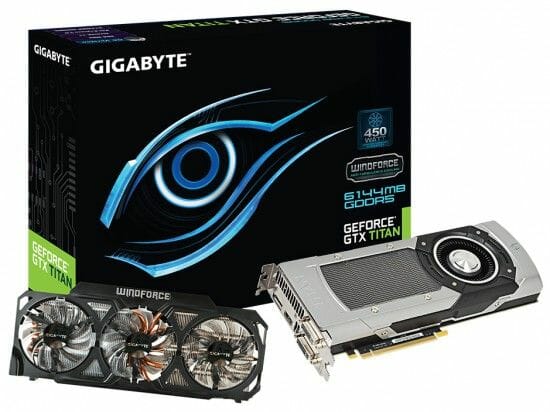
Right now it is the world’s fastest single-processor graphics card. Well, EVGA offers the GeForce GTX Titan Black Hydro Copper Signature which is as fast but requires liquid cooling whereas the Gigabyte product can do with air cooling only.
Specifications and Recommended Price
The specs and price of the Gigabyte GeForce GTX Titan Black GHz Edition are listed in the table below in comparison with those of the Nvidia GeForce GTX Titan Black, Nvidia GeForce GTX 780 Ti and AMD Radeon R9 290X.
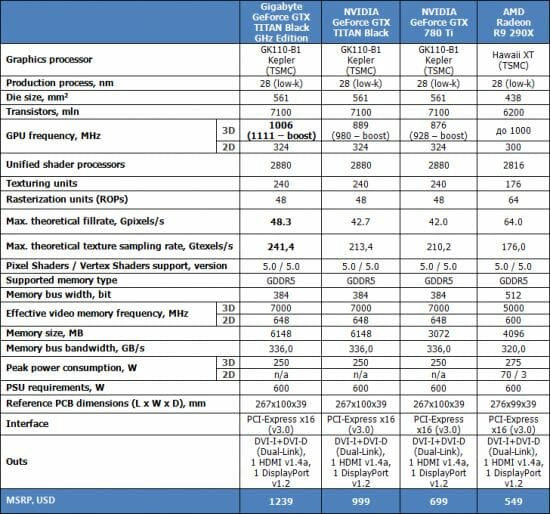
Packaging and Accessories
The Gigabyte GeForce GTX Titan Black GHz Edition is shipped in a cardboard box which is about twice as large as regular boxes with top-end graphics cards. There’s a picture of an augmented eye on the front of the packaging. Next to it, you can see the product’s model name, clock rates, cooling system type, and graphics memory type and amount.
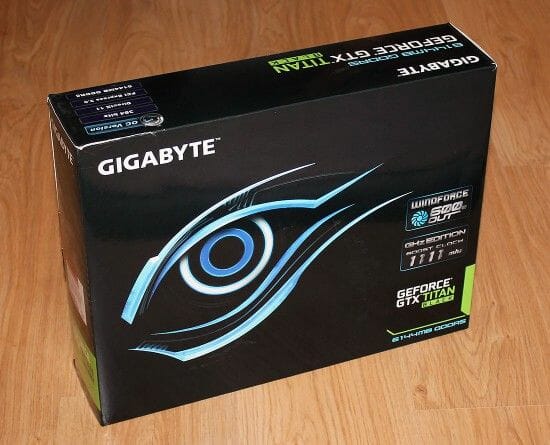
There’s more information on the back of the box: descriptions of Nvidia technologies, a list of advantages of the exclusive Windforce 3X 600W cooling system, product specifications, and a demo of the OC Guru II utility.

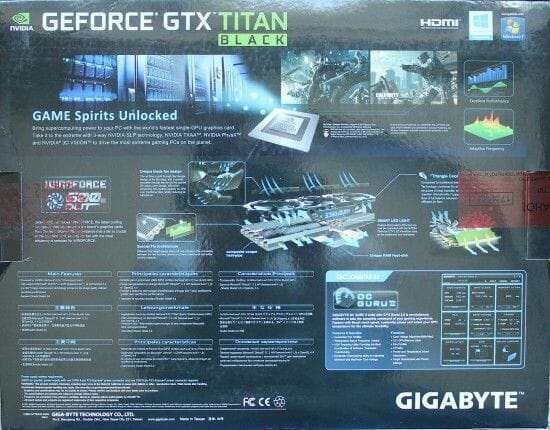
There’s a black cardboard box inside the colorful wrapper. When you open it up, you’ll find a huge mouse pad lying on top of the contents.
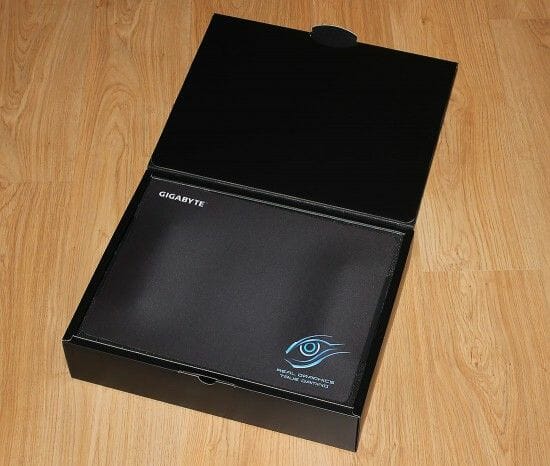
Below it, there’s a flat box with accessories.
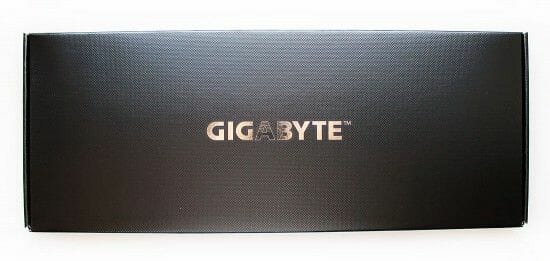
It contains two power adapters, an HDMI cable, a DVI->D-Sub adapter, a warranty coupon, a brief installation guide, and a CD with drivers and software.
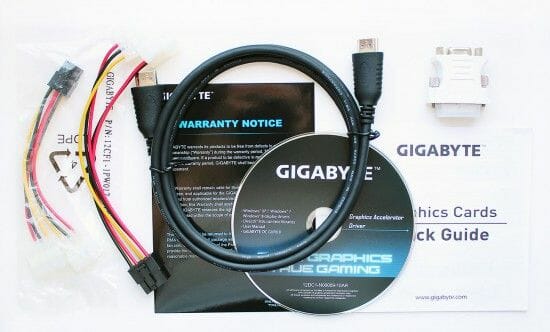
No games are included. The manufacturer suggests that people who can afford such an expensive graphics card can buy their games themselves as well. Anyway, we guess a couple of the latest titles would be a nice extra.
There are two compartments at the bottom of the packaging. The graphics card is fixed inside one of them. The other contains a small box with the Windforce 3X 600W cooler.
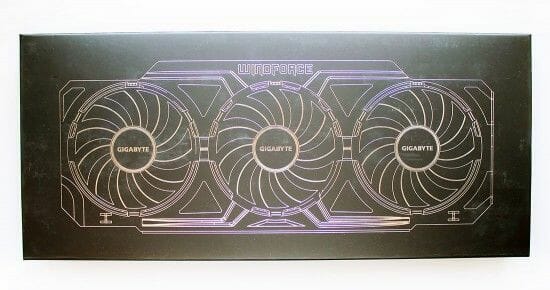
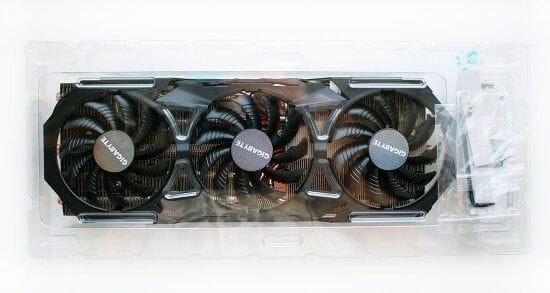
The Gigabyte GeForce GTX Titan Black GHz Edition is manufactured in Taiwan and is shipped with a 3-year warranty. We couldn’t find any information about its recommended price but it is available from online stores at $1239, which is 24% more than the recommended price of the regular GeForce GTX Titan Black.
PCB Design and Features
Although the Gigabyte GeForce GTX Titan Black GHz Edition is shipped with an alternative cooling system, it comes as an ordinary reference GeForce GTX Titan Black.
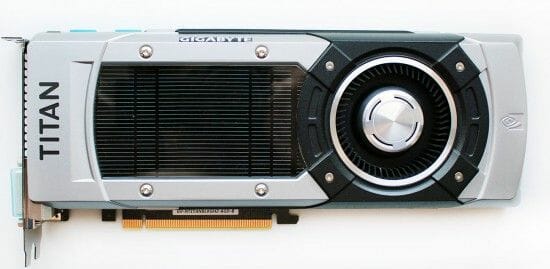
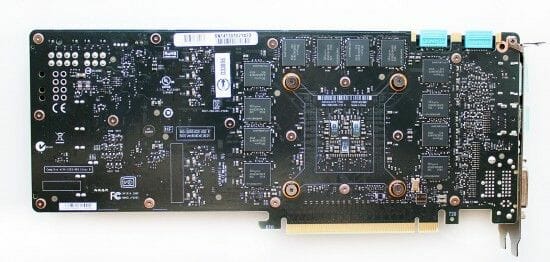
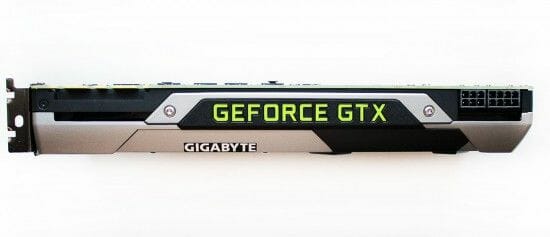
The logo on the cooler’s casing and the information on the sticker on the reverse side of the PCB are the only indications that it is a product from Gigabyte.
The Gigabyte GeForce GTX Titan Black GHz Edition has a standard selection of video outputs including dual-link DVI-I and DVI-D connectors, one HDMI 1.4a and one DisplayPort 1.2. There’s also a vent grid in the card’s mounting bracket to exhaust the hot air out of the computer case.
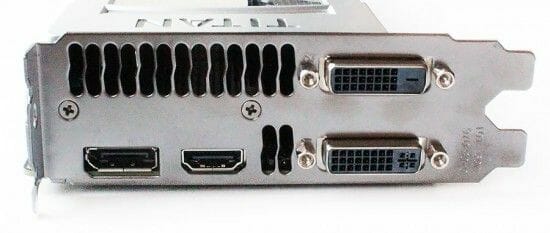
Like a regular GeForce GTX Titan Black, the Gigabyte version has one 8-pin and one 6-pin power connector. There are no differences in terms of the SLI connectors, either.
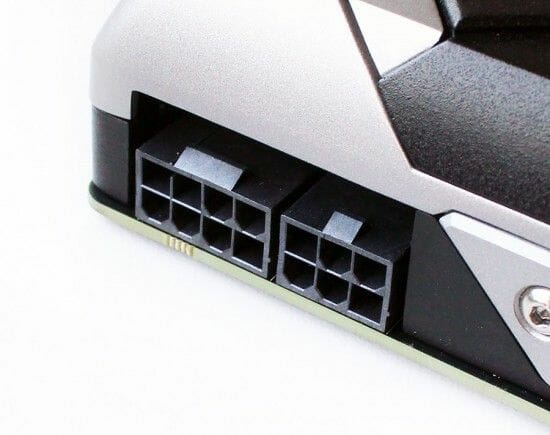
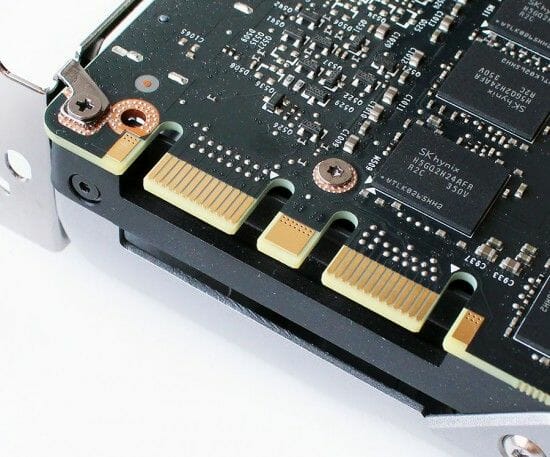
Notwithstanding the increased GPU clock rate, the graphics card is specified to need up to 250 watts of power and is recommended to be used with a 600-watt or higher power supply.
Beneath the default cooler we found a copy of the reference PCB of the GeForce GTX Titan Black/Titan/780 Ti models.
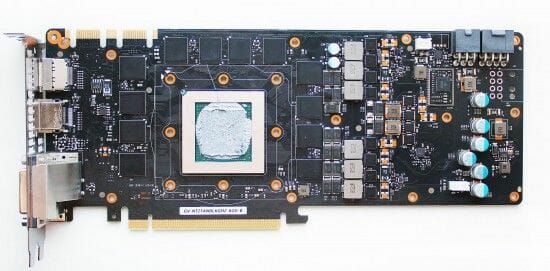
Here is 8-phase GPU power system with DrMOS transistors.
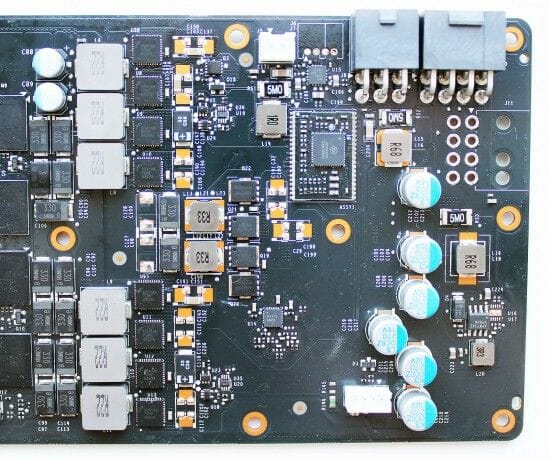
The GPU voltage regulator is based on an ON Semiconductor NCP4206 controller.
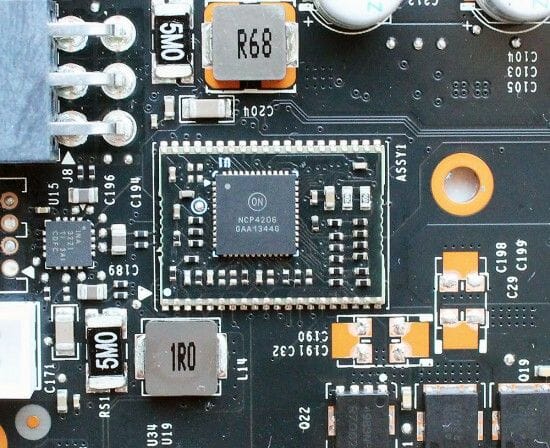
Manufactured on the 47th week of 2013 (in the middle of November), the GPU is somewhat older than the Zotac’s but is the newest B1 revision, too.
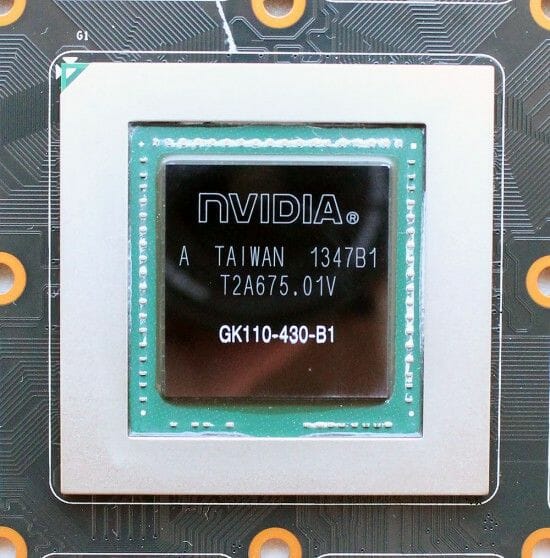
We don’t know if some special GPU samples are selected for this graphics card, but its base 3D clock rate is set as high as 1006 MHz, which is 13.2% higher than the clock rate of the reference GeForce GTX Titan Black. And its boost clock rate is 1111 MHz! That’s impressive and even risky factory overclocking, yet it makes the card the fastest single-GPU solution on the market. The ASIC quality of the GPU isn’t very high at only 72.1%.
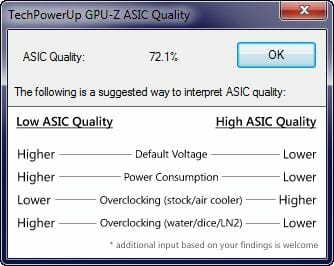
It proves again that there’s no correlation between ASIC quality and frequency potential.
Like a regular Titan, the card carries 6 gigabytes of GDDR5 memory – in 12 chips from SK Hynix (H5GQ2H24AFR-R2C).
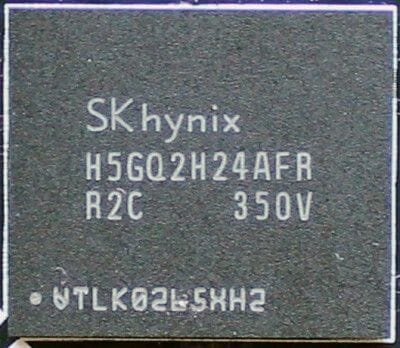
The memory chips are rated and clocked at 7000 MHz, so there is no factory overclocking here. It may be a downside in terms of marketing because even an extra 200 MHz to the memory frequency would have made the card even more attractive in the user’s eyes. But if we talk about performance, memory overclocking doesn’t provide tangible benefits for Nvidia-based products of this class.
Here’s a summary of the Gigabyte GeForce GTX Titan Black GHz Edition specs from the GPU-Z utility.
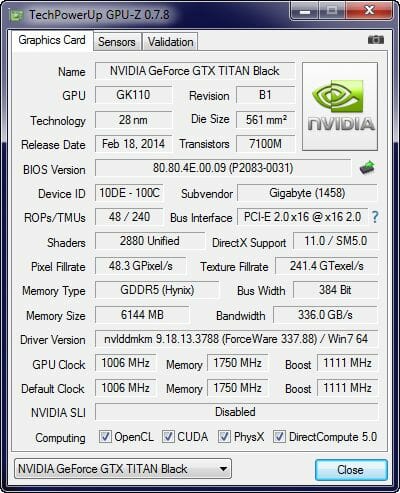
Like all reference GeForce GTX Titan Black products, the graphics card comes with two BIOS chips.
Cooling Systems: Efficiency and Noise Level
Before we get down to checking out the exclusive Windforce 3X 600W cooler, we want to test the card’s default cooling system. The latter combines a vapor chamber with an aluminum heatsink and additionally has a metallic plate with thermal pads for memory chips and power system components. The whole arrangement is cooled by a radial fan with adaptive PWM-based speed regulation.
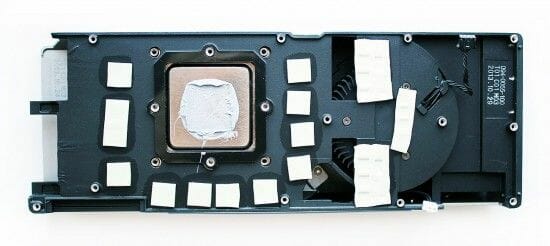
To measure the temperature of the Gigabyte GeForce GTX TITAN Black GHz Edition we ran Aliens vs. Predator (2010) five times with maximum visual quality settings, at a resolution of 2560×1440 pixels, with 16x anisotropic filtering and 4x MSAA.
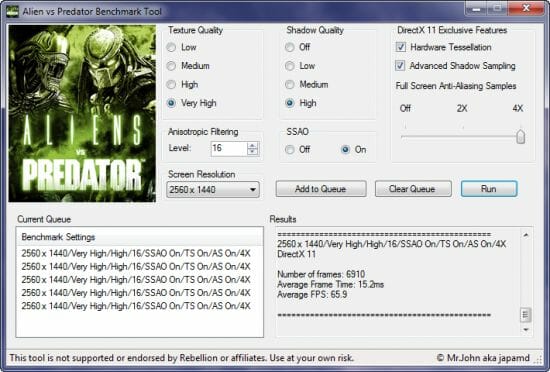
We used MSI Afterburner 3.0.0 and GPU-Z version 0.7.8 to monitor temperatures inside the closed computer case. The computer’s configuration is detailed in the following section of our review. All tests were performed at 26.5°C room temperature.
With the cooler’s fan regulated automatically, the Gigabyte is as hot as the Zotac GeForce GTX Titan Black: up to 87°C. The speed of the fan is higher at 3420 RPM, though.
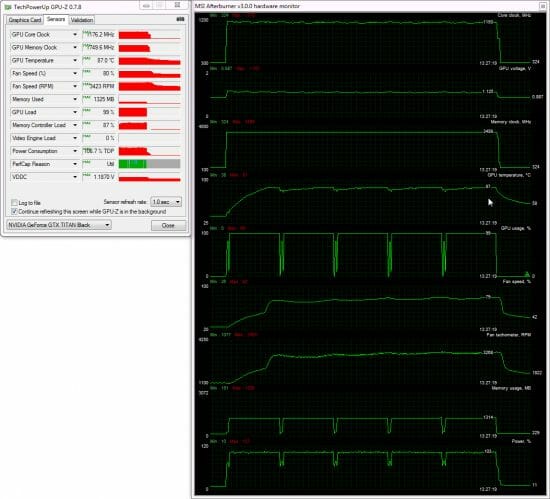
We must note that the ambient temperature was 1.5°C higher during this test than when we had tested the Zotac card.
And if the fan is set at its maximum speed (4280 RPM according to our monitoring tools), the peak GPU temperature is no higher than 77°C.
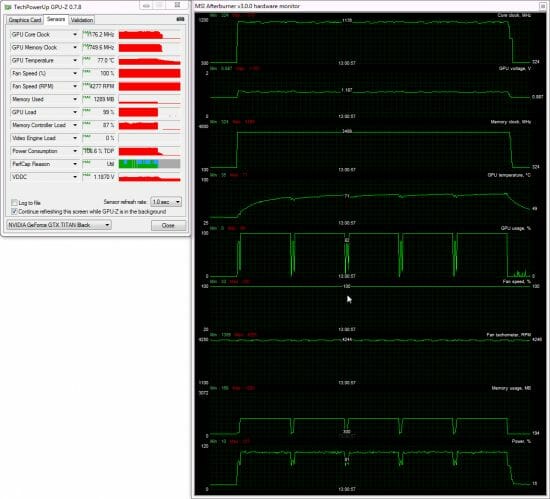
So the temperature seems to be normal for a graphics card of this class.
The Windforce 3X 600W comes with screws, thermal pads, a cleaning napkin, an L-shaped key, and two syringes with thermal grease.

There’s also a detailed installation guide describing the whole procedure starting from removing the default cooler.
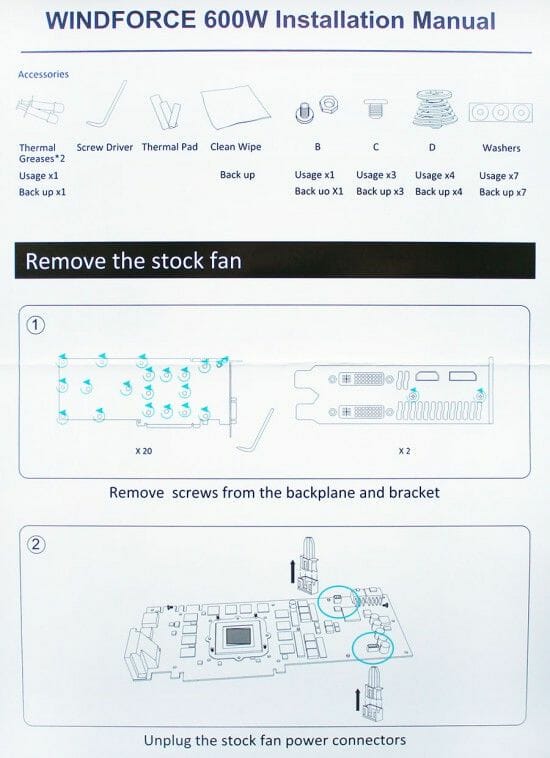
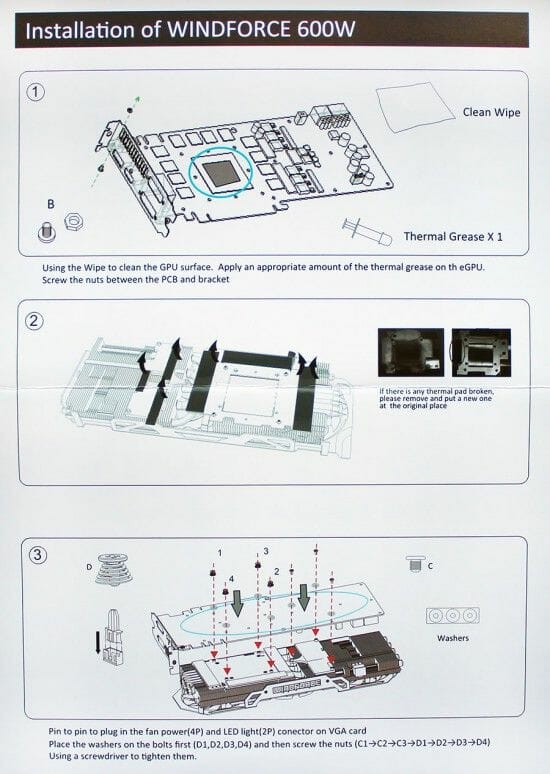
The Windforce 3X 600W has a number of improvements over the original Windforce cooler. It is rather compact, fitting within the standard dual-slot form-factor.
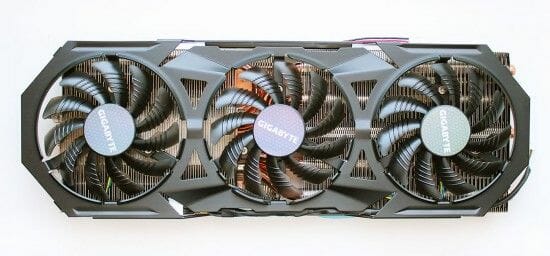
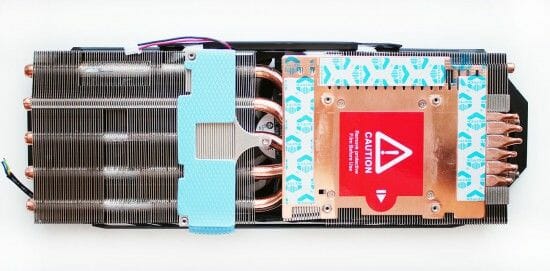
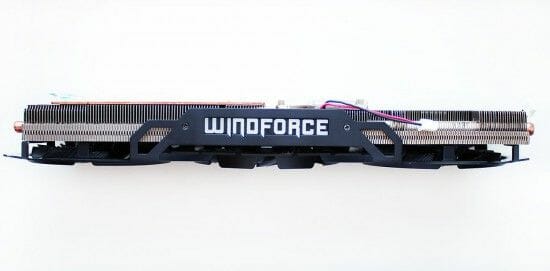
It has an aluminum heatsink with Triangle Cool technology and innovative finning and features composite heat pipes. The cooler also has an aluminum frame with three high-airflow fans.
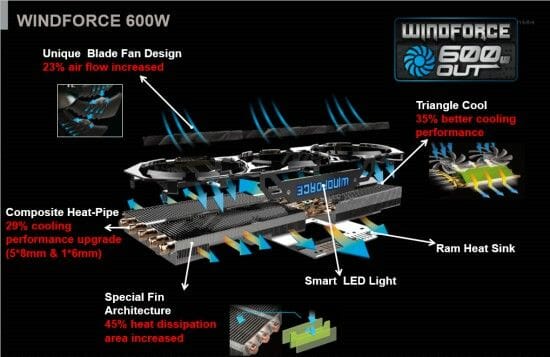
There are five 8mm copper pipes and one 6mm pipe in the heatsink.
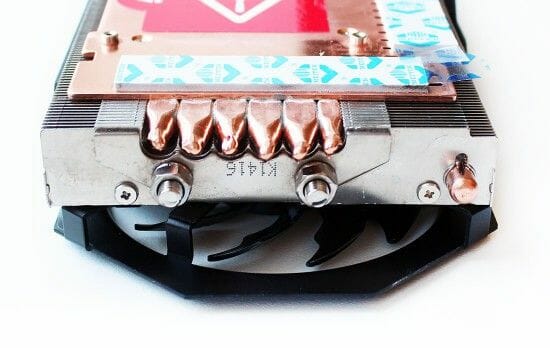
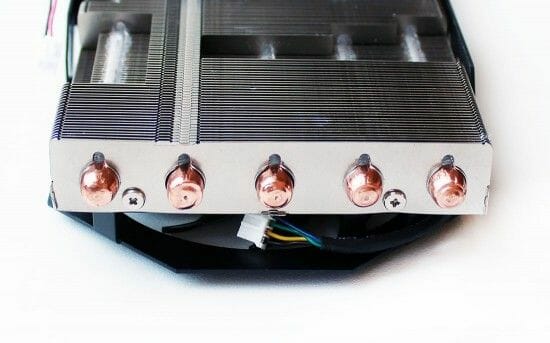
The pipes pierce both sections of the densely finned heatsink and contact with the entire length of the copper base. The heat pipes are soldered to the heatsink fins as well as to the cooler’s base.
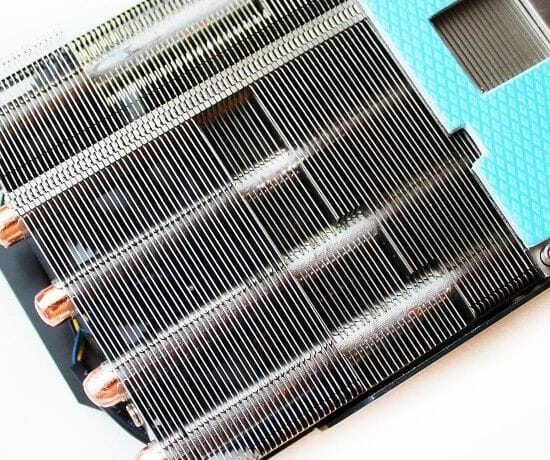
The cooler’s composite heat pipes feature an additional capillary layer to improve heat transfer.
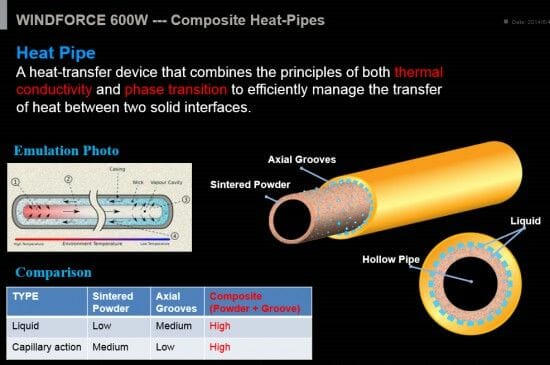
The fans have also been improved. They’ve got notched blades and an additional “fin” at the front.
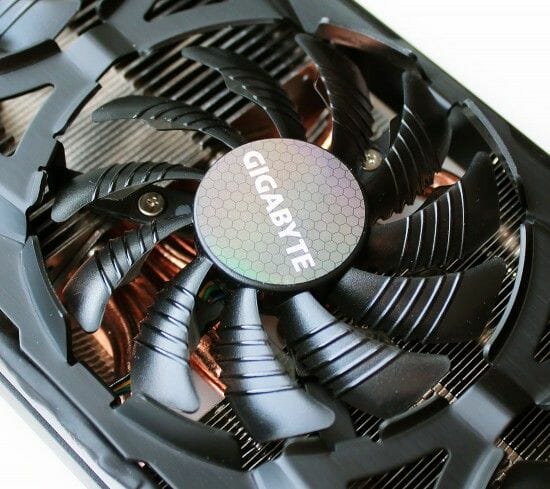
Gigabyte claims these optimizations enhance the air flow by 23% compared to conventionally shaped fans.
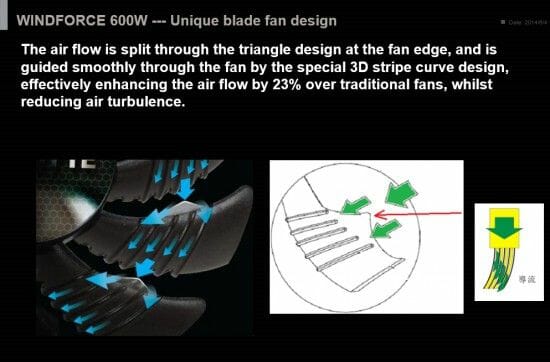
The fans are PWM-regulated in a range of 1000 to 4300 RPM.
The Windforce 3X 600W also features smart highlighting on its casing. We don’t know what’s so smart about it as it always stayed blue throughout our tests.
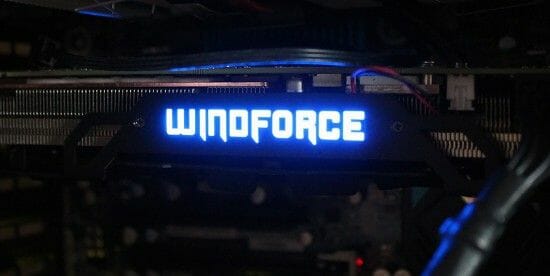
It is easy to install the cooler on the graphics card. Just don’t forget to unpeel the protective film from its thermal pads and apply some thermal grease on the GPU. The cooler adds 20 mm to the graphics card’s length, yet looks quite compact overall.
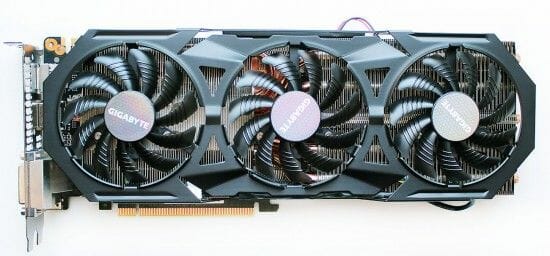
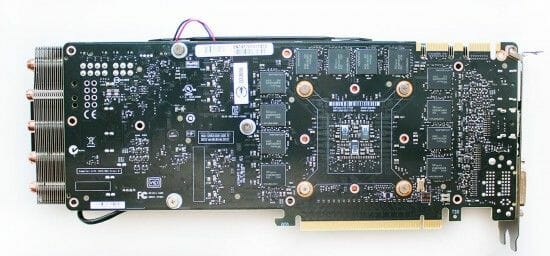
Our first test of the Windforce 3X 600W proved its high efficiency.
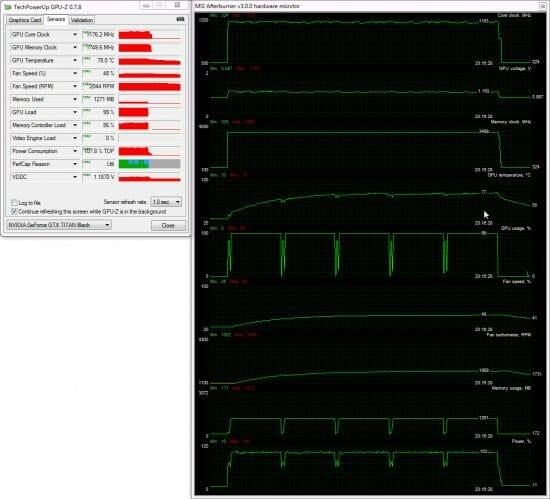
In the automatic regulation mode, when the fans accelerated steadily from a silent 1000 RPM to a comfortable 2040 RPM, the peak GPU temperature was 78°C. It is about 20°C better than with the reference cooler and much quieter, too! That’s just an excellent performance for a cooler of the world’s fastest graphics card.
And if you want to lower the temperature even more, you can set the fans at their maximum speed. The result is comparable to what you’d get with an entry-level liquid cooling system.
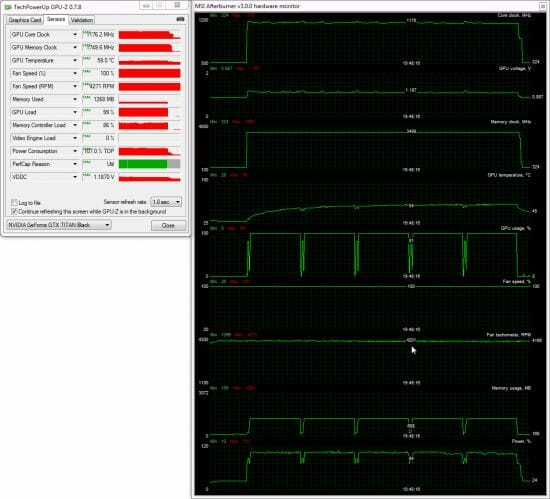
The GPU is no hotter than 58°C. And we’re talking about a GK110-B1 die which would be clocked at up to 1176 MHz during our test. So, Gigabyte has come up with an extremely high-performance cooler. Let’s check out its noise level, though.
We measured the level of noise using an electronic noise-level meter CENTER-321 in a closed and quiet room about 20 sq. meters large. The noise-level meter was set on a tripod at a distance of 15 centimeters from the graphics card which was installed on an open testbed. The mainboard with the graphics card was placed at an edge of a desk on a foam-rubber tray. The bottom limit of our noise-level meter is 29.8 dBA whereas the subjectively comfortable (not low, but comfortable) level of noise when measured from that distance is about 36 dBA. The speed of the graphics card’s fans was being adjusted by means of a controller that changed the supply voltage in steps of 0.5 V.
The Gigabyte GeForce GTX Titan Black GHz Edition will be compared with the reference Nvidia GeForce GTX Titan Black and AMD Radeon R9 290X as well as with the original MSI GeForce GTX 780 Ti Gaming and ASUS ROG Matrix GTX 780 Ti Platinum (the latter will also take part in our performance tests). The vertical dotted lines mark the top speed of the coolers’ fans in the automatic PWM-based regulation mode.
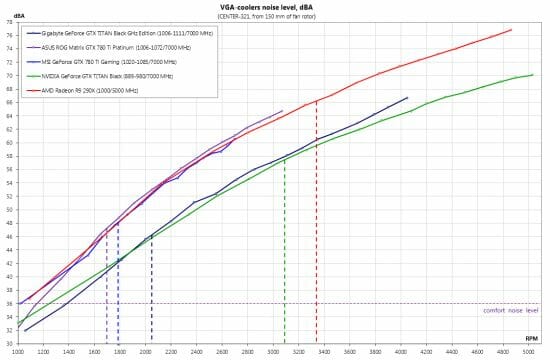

Despite the serious competition, the Gigabyte GeForce GTX Titan Black is superior to the original cards from MSI and ASUS in terms of noisiness. The three fans of its Windforce 3X 600W cooler are quieter at any speed. The reference GeForce GTX Titan may seem to be comparable to the Gigabyte in this test, but the Windforce 3X 600W is much better than the reference cooler if you compare their top speeds in the automatic regulation mode.
So, the new card from Gigabyte is quieter than its opponents and, unlike them, is virtually silent in 2D applications.
Overclocking Potential
Frankly speaking, we didn’t expect much from overclocking a GPU which already worked at a heavily increased frequency, yet we did manage to step up its clock rate by an additional 60 MHz. The graphics memory was overclocked by 840 MHz.
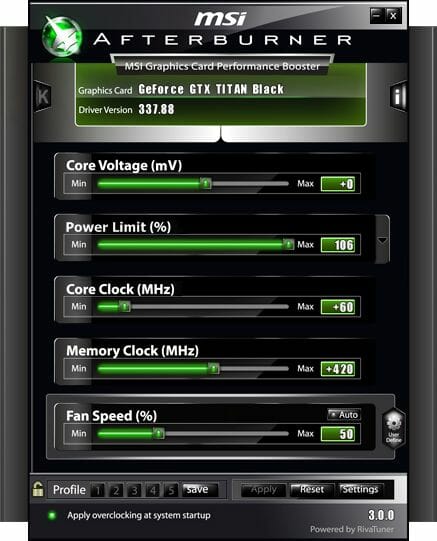
The resulting clock rates were 1066-1171/7840 MHz.
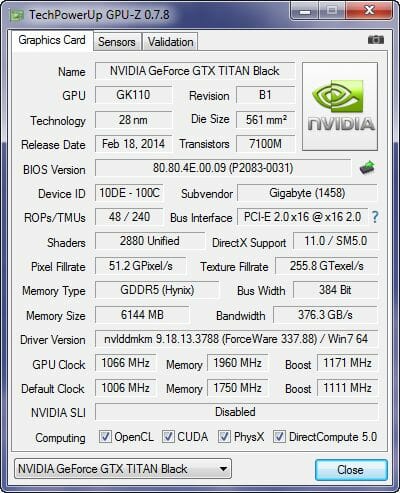
Interestingly, the overclocked card had the same temperature, although its fans sped up a little.
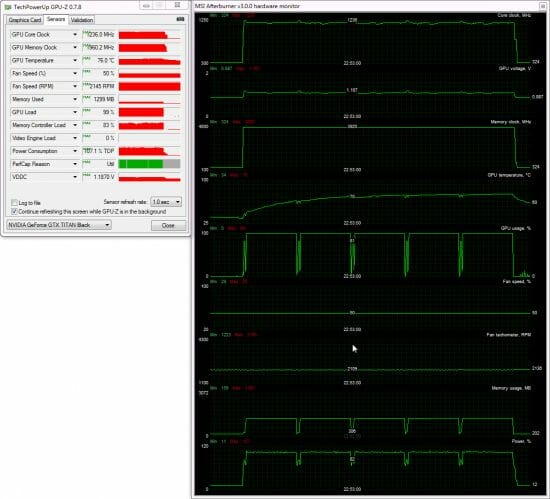
Considering the high performance of the Windforce 3X 600W cooler, we also tried to overclock after increasing the GPU voltage. We raised the clock rate by 110 MHz, yet had some visual artifacts. So, such overclocking may be useful for setting benchmarking records but not for actual gaming.
Testbed and Methods
Here is the list of components we use in our testbed.
- Mainboard: Intel Siler DX79SR (Intel X79 Express, LGA2011, BIOS 0594 dated 06.08.2013)
- CPU: Intel Core i7-3970X Extreme Edition 3.5/4.0 GHz (Sandy Bridge-E, C2, 1.1 V, 6x256KB L2 cache, 15MB L3 cache)
- CPU cooler: Phanteks PH-TC14PЕ (2×900 RPM)
- Thermal grease: ARCTIC MX-4
- Graphics cards:
- Nvidia GeForce GTX 690 (2x2GB, 915-1019/6008 MHz)
- Gigabyte GeForce GTX Titan Black GHz Edition (6GB, 1006-1111/7000 MHz and 1066-1171/7840 MHz)
- Zotac GeForce GTX Titan Black (6GB, 889-980/7000 MHz)
- ASUS ROG Matrix GTX 780 Ti Platinum (3GB, 1006-1072/7000 MHz)
- AMD Radeon R9 290X (4GB, 1000/5000 MHz)
- System memory: DDR3 4x8GB G.SKILL TridentX F3-2133C9Q-32GTX (XMP: 2133 MHz, 9-11-11-31, 1.6 volts)
- System disk: SSD 256GB Crucial m4 (SATA 6 Gbit/s, CT256M4SSD2, BIOS v070H)
- Games/software disk: Western Digital VelociRaptor (SATA-2, 300 GB, 10000 RPM, 16MB cache, NCQ) in a Scythe Quiet Drive 3.5″ enclosure
- Backup disk: Samsung EcoGreen F4 HD204UI (SATA-2, 2 TB, 5400 RPM, 32 MB cache, NCQ)
- Sound card: Auzen X-Fi HomeTheater HD
- Computer case: Antec Twelve Hundred (front panel: three Noiseblocker NB-Multiframe S-Series MF12-S2 fans at 1020 RPM; back panel: two Noiseblocker NB-BlackSilentPRO PL-1 fans at 1020 RPM; top panel: one preinstalled 200mm fan at 400 RPM)
- Control & monitoring panel: Zalman ZM-MFC3
- Power supply: Corsair AX1200i (1200 W), 120mm fan
- Monitor: 27″ Samsung S27A850D (DVI-I, 2560×1440, 60 Hz)
We’ll compare the new card with a dual-processor Nvidia GeForce GTX 690 2x2GB and a Zotac GeForce GTX Titan Black 6GB working at their default clock rates.
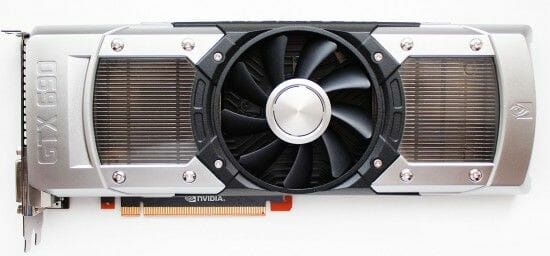
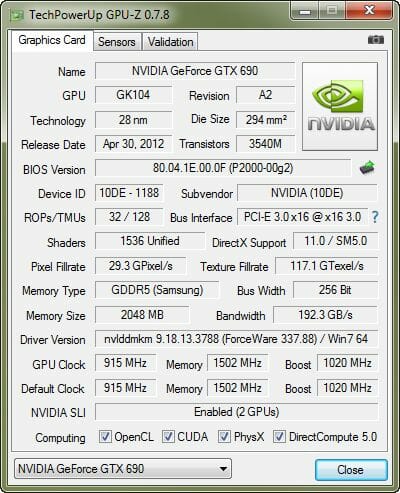
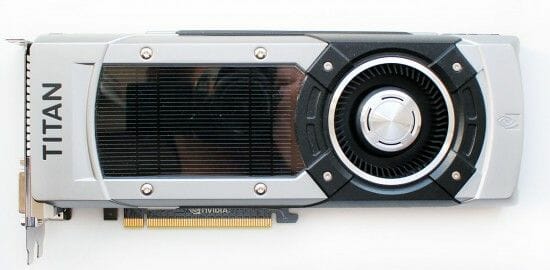
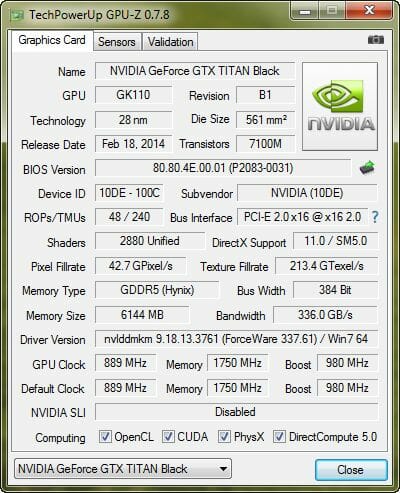
We also have one of the fastest versions of GeForce GTX 780 Ti 3GB (1006-1072/7000 MHz) and a reference AMD Radeon R9 290X 4GB.
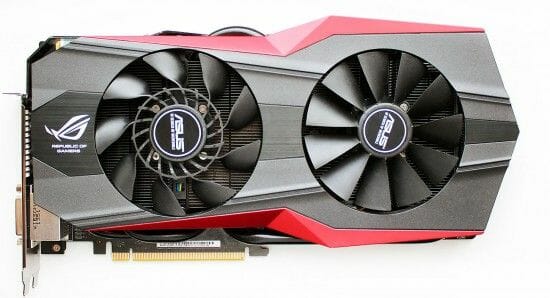
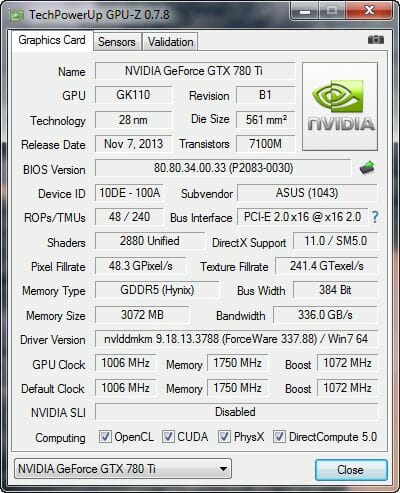
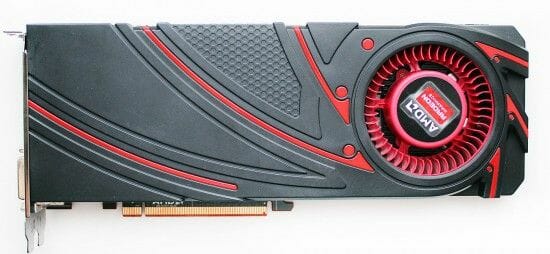
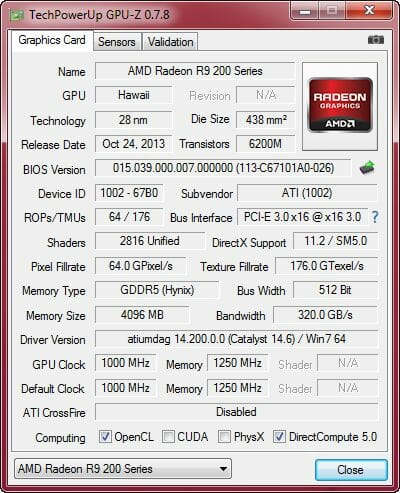
We set Power Limit at its maximum on each graphics card.
In order to lower the dependence of the graphics cards’ performance on the overall platform speed, we overclocked our 32nm six-core CPU to 4.8 GHz by setting its frequency multiplier at x48 and enabling Load-Line Calibration. The CPU voltage was increased to 1.385 volts in the mainboard’s BIOS.
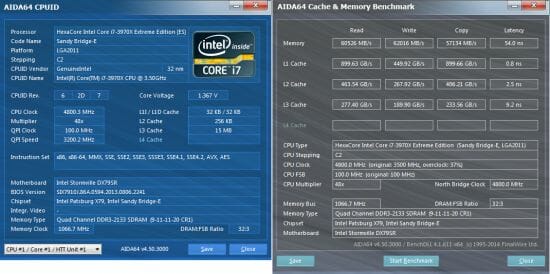
Hyper-Threading was turned on. We used 32 GB of system memory at 2.133 GHz with timings of 9-11-11-20_CR1 and voltage of 1.6125 volts.
The testbed ran Microsoft Windows 7 Ultimate x64 SP1 with all critical updates installed. We used the following drivers:
- Intel Chipset Drivers – 9.4.4.1006 WHQL dated 21.09.2013
- DirectX End-User Runtimes, dated 30 November 2010
- AMD Catalyst 14.6 Beta (14.100.0.0) dated 27.05.2014
- Nvidia GeForce 337.88 WHQL dated 26.05.2014
We benchmarked the graphics cards’ performance at two display resolutions: 1920×1080 and 2560×1440 pixels. There were two visual quality modes: “Quality+AF16x” means the default texturing quality in the drivers + 16x anisotropic filtering whereas “Quality+ AF16x+MSAA 4x(8x)” means 16x anisotropic filtering and 4x or 8x antialiasing. In some games we use antialiasing algorithms other than MSAA as indicated below and in the diagrams. We enabled anisotropic filtering and full-screen antialiasing from the game’s menu. If the corresponding options were missing, we changed these settings in the Control Panels of the Catalyst and GeForce drivers. We also disabled V-Sync there. There were no other changes in the driver settings.
The graphics cards were tested in two benchmarks and 14 games updated to the latest versions.
- 3DMark (2013) (DirectX 9/11) version 1.2.250.0: Cloud Gate, Fire Strike and Fire Strike Extreme scenes.
- Unigine Valley Bench (DirectX 11) version 1.0: Maximum visual quality settings, 16x AF and/or 4x MSAA, 1920×1080.
- Total War: SHOGUN 2 – Fall of the Samurai (DirectX 11) version 1.1.0: integrated benchmark (the Sekigahara battle) with maximum visual quality settings and 8x MSAA.
- Sniper Elite V2 Benchmark (DirectX 11) version 1.05: Adrenaline Sniper Elite V2 Benchmark Tool v1.0.0.2 BETA with maximum graphics quality settings (“Ultra” profile), Advanced Shadows: HIGH, Ambient Occlusion: ON, Stereo 3D: OFF, Supersampling: OFF, two sequential runs of the test.
- Sleeping Dogs (DirectX 11) version 1.5: Adrenaline Sleeping Dogs Benchmark Tool v1.0.2.1 with maximum image quality settings, Hi-Res Textures pack installed, FPS Limiter and V-Sync disabled, two consecutive runs of the built-in benchmark with quality antialiasing at Normal and Extreme levels.
- Hitman: Absolution (DirectX 11) version 1.0.447.0: built-in test with Ultra settings, enabled tessellation, FXAA and global lighting.
- Crysis 3 (DirectX 11) version 1.2.0.1000: maximum visual quality settings, Motion Blur – Medium, lens flares – on, FXAA and MSAA 4x, two consecutive runs of a scripted scene from the beginning of the “Swamp” mission (110 seconds long).
- Tomb Raider (2013) (DirectX 11) version 1.1.748.0: we used Adrenaline Benchmark Tool, all image quality settings set to “Ultra”, V-Sync disabled, FXAA and 2x SSAA antialiasing enabled, TessFX technology activated, two consecutive runs of the in-game benchmark.
- BioShock Infinite (DirectX 11) version 1.1.25.5165: we used Adrenaline Action Benchmark Tool with “Ultra” and “Ultra+DOF” quality settings, two consecutive runs of the in-game benchmark.
- Metro: Last Light (DirectX 11) version 1.0.0.15: we used the built-in benchmark for two consecutive runs of the D6 scene. All image quality and tessellation settings were at “Very High”, Advanced PhysX technology enabled, with and without SSAA antialiasing.
- GRID 2 (DirectX 11) version 1.0.85.8679: we used the built-in benchmark, the visual quality settings were all at their maximums, the tests were run with and without MSAA 8x antialiasing with eight cars on the Chicago track.
- Company of Heroes 2 (DirectX 11) version 3.0.0.13946: two consecutive runs of the integrated benchmark at maximum image quality and physics effects settings.
- Total War: Rome II (DirectX 11) version 1.11.0.0: Extreme quality, V-Sync disabled, SSAA enabled, two consecutive runs of the integrated benchmark.
- Batman: Arkham Origins (DirectX 11) version 1.0 update 8: Ultra visual quality, V-Sync disabled, all the effects enabled, all DX11 Enhanced features enabled, Hardware Accelerated PhysX = Normal, two consecutive runs of the in-game benchmark.
- Battlefield 4 (DirectX 11) – version 111433: Ultra settings, two successive runs of a scripted scene from the beginning of the “Tashgar” mission (110 seconds long), with the Mantle API enabled for AMD-based cards.
- Thief (DirectX 11) version 1.5 build 4158.5: Maximum visual quality settings, Parallax Occlusion Mapping and Tessellation enabled, a double run of the in-game benchmark with the Mantle API enabled for AMD-based cards.
We publish the bottom frame rate for games that report it. Each test was run twice, the final result being the best of the two if they differed by less than 1%. If we had a larger difference, we reran the test at least once again to get repeatable results.
Performance
The results of the Gigabyte GeForce GTX Titan Black GHz Edition are colored dark-blue in the diagrams. The color of the Nvidia GeForce GTX 690 is turquoise. The Zotac GeForce GTX Titan Black and the ASUS ROG Matrix GTX 780 Ti Platinum are light green and the AMD Radeon R9 290X is red. Since we’re benchmarking premium graphics solutions, we will focus on the 2560×1440 + AA settings.
3DMark (2013)
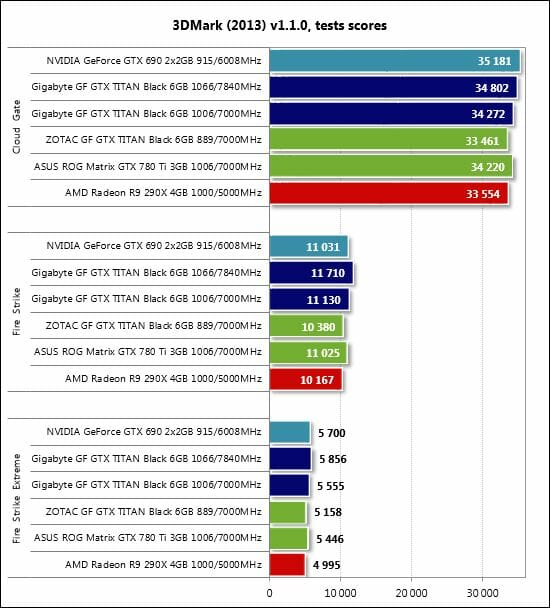
The tested cards are all comparable to each other in 3DMark. The Gigabyte GeForce GTX Titan Black GHz Edition wins in the heaviest test mode but only when it is overclocked.
Unigine Valley Bench
The gaps between the tested cards are larger in this benchmark.
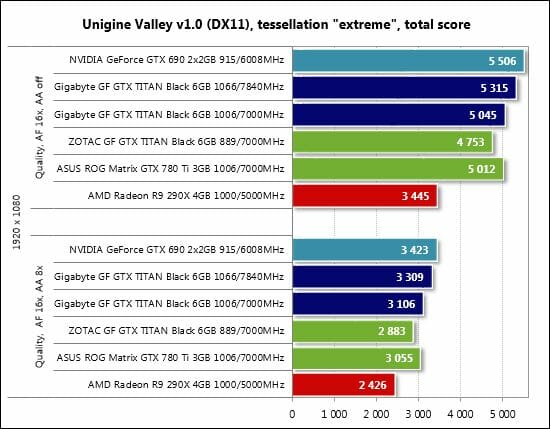
The Gigabyte GeForce GTX Titan Black GHz Edition can’t beat the dual-processor GeForce GTX 690 even when overclocked but outperforms Zotac’s reference GeForce GTX Titan Black by almost 8%. The ASUS ROG Matrix GTX 780 Ti Platinum does well in this test, its GPU clock rate being almost the same as the Gigabyte card’s.
Total War: SHOGUN 2 – Fall of the Samurai
We can see the same picture in this game as in the previous benchmark.
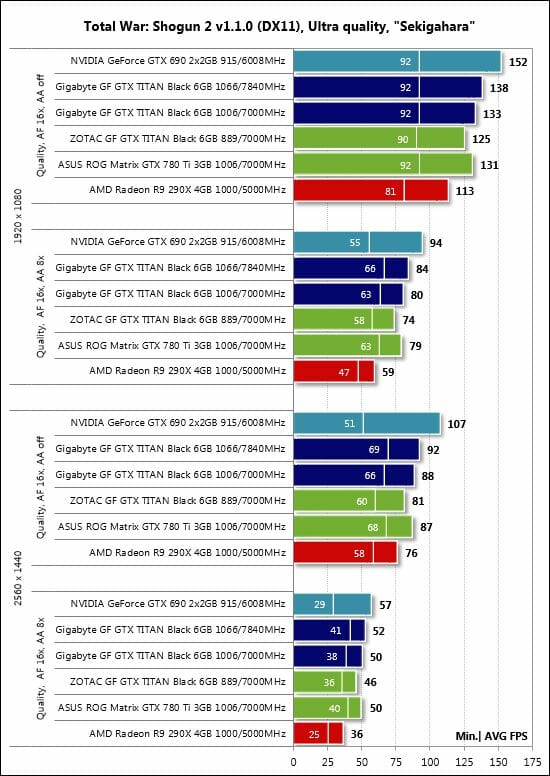
Sniper Elite V2 Benchmark
The AMD Radeon R9 290X isn’t good here, but otherwise we have the same standings as in the two previous tests.
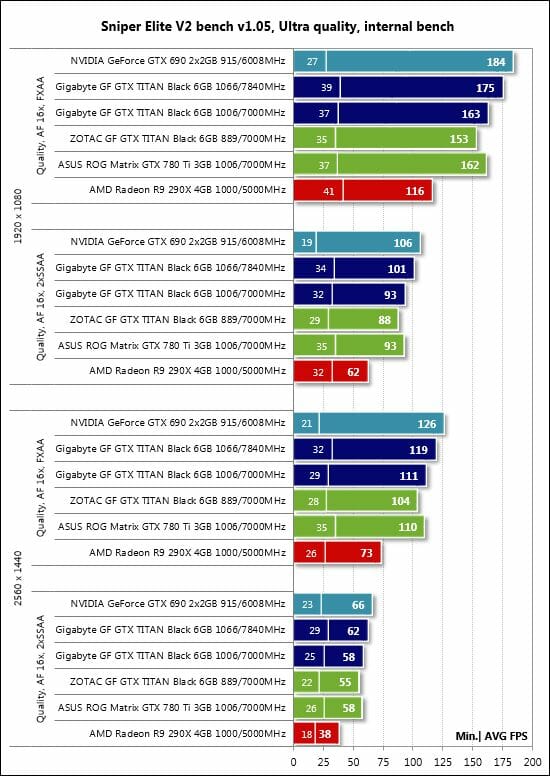
Sleeping Dogs
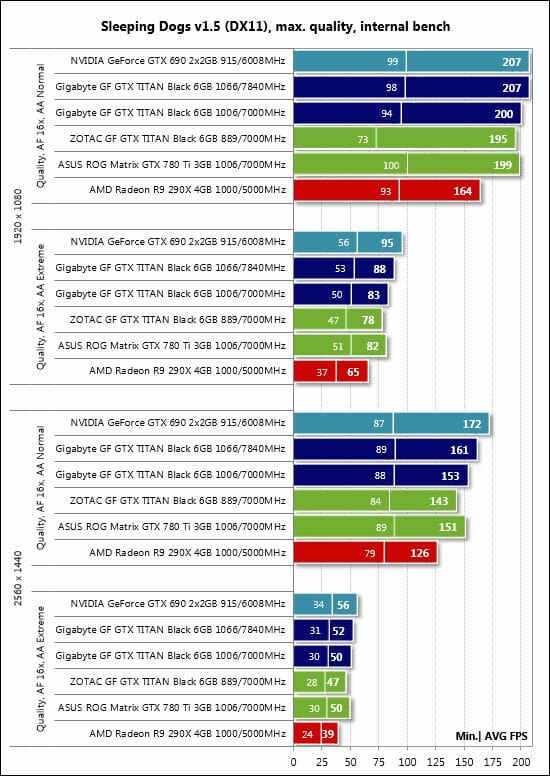
Hitman: Absolution
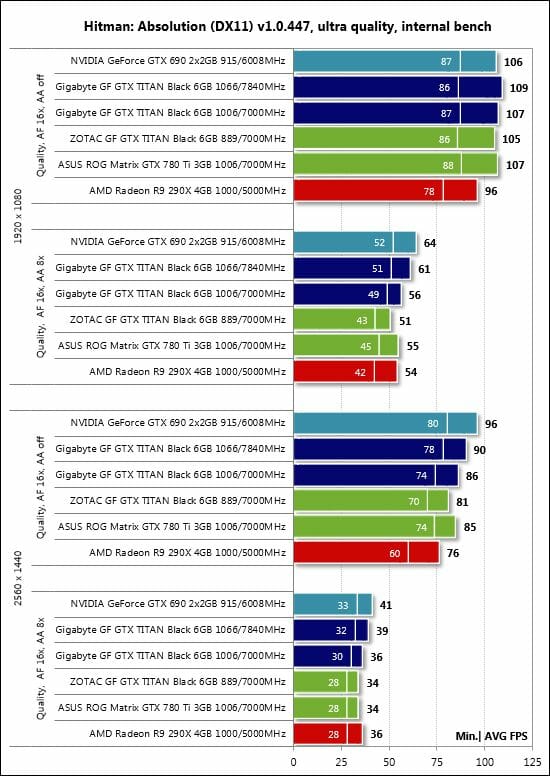
We don’t see anything unusual in Hitman: Absolution and Sleeping Dogs.
Crysis 3
Well, Crysis 3 and Tomb Raider (2013) don’t show anything extraordinary, either.
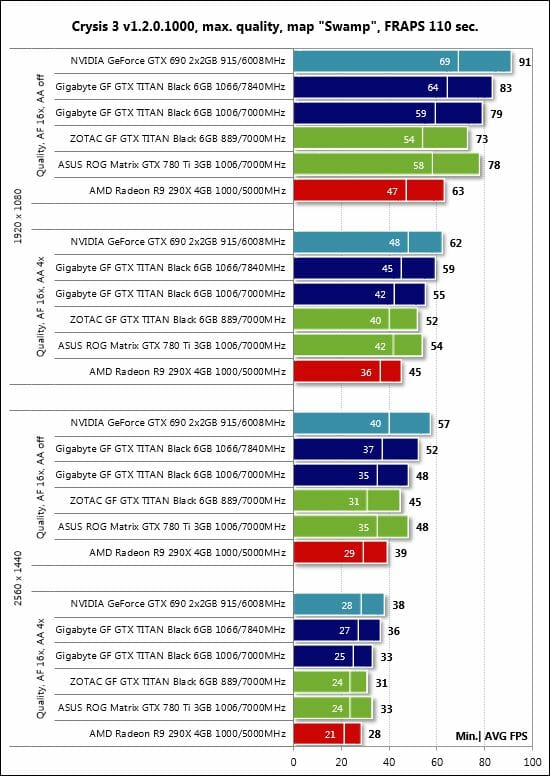
Tomb Raider (2013)
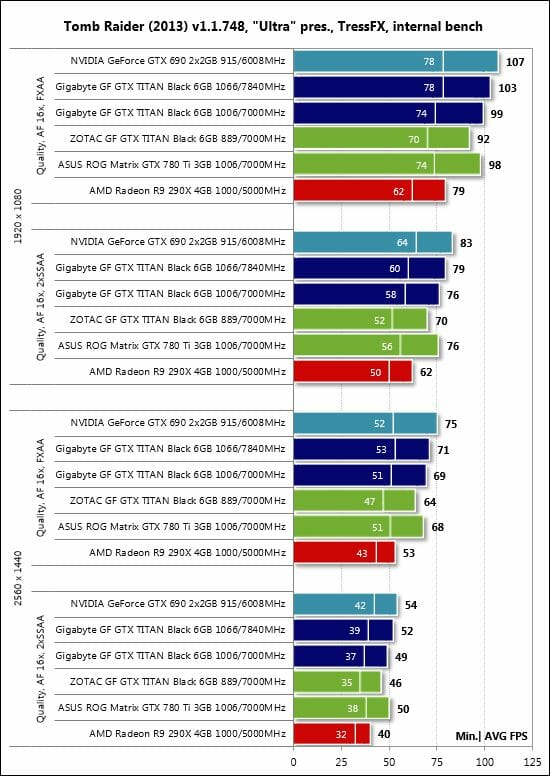
BioShock Infinite
BioShock Infinite, as usual, has low bottom speed on the Nvidia-based products but the average frame rates are normal enough.
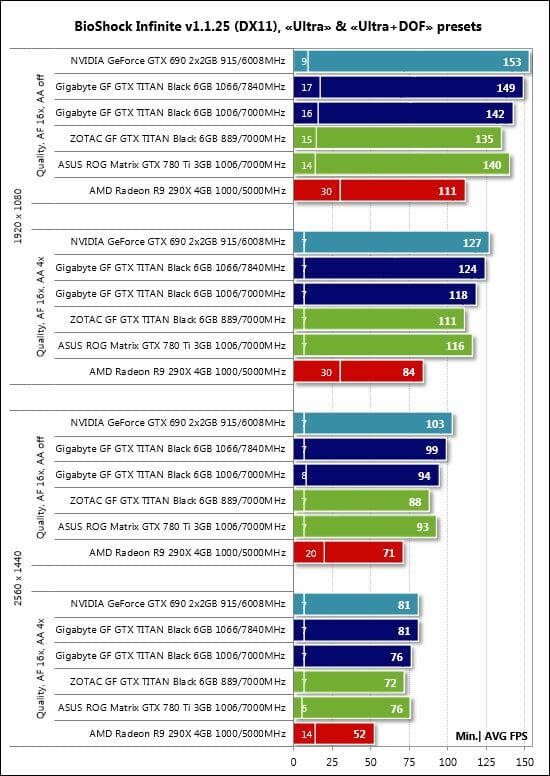
Metro: Last Light
The Advanced PhysX option lowers the speed of the AMD Radeon R9 290X and makes SLI ineffective because the GeForce GTX 690 is inferior to the Gigabyte GeForce GTX Titan Black GHz Edition and ASUS ROG Matrix GTX 780 Ti Platinum.
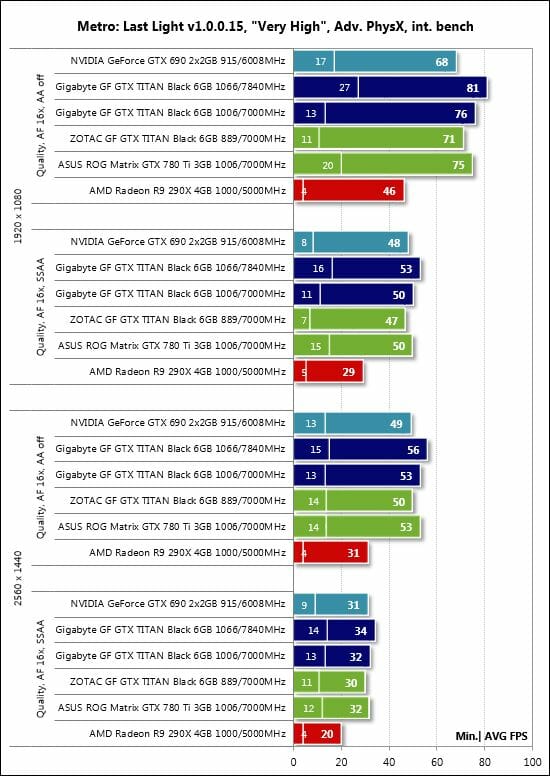
When the additional physics effects are turned off, the AMD-based product improves its performance, yet still cannot catch up with Nvidia’s flagships. The GeForce GTX 690 is still unable to beat the Titan Black and the 780 Ti.
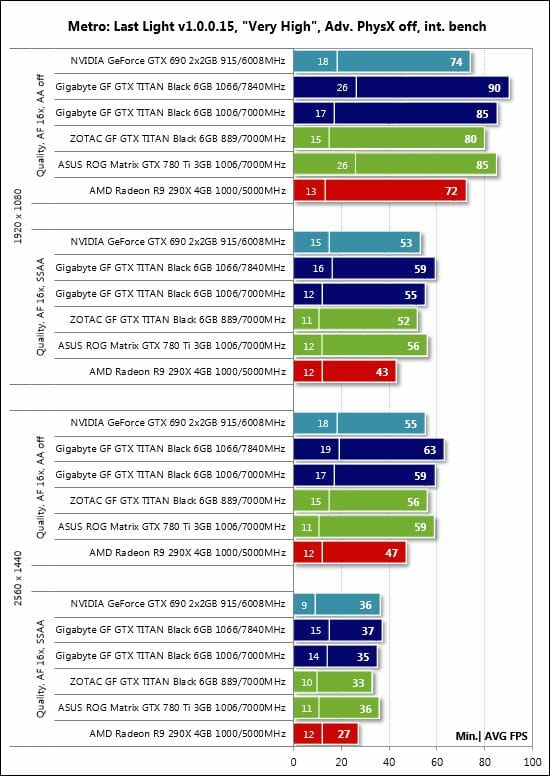
GRID 2
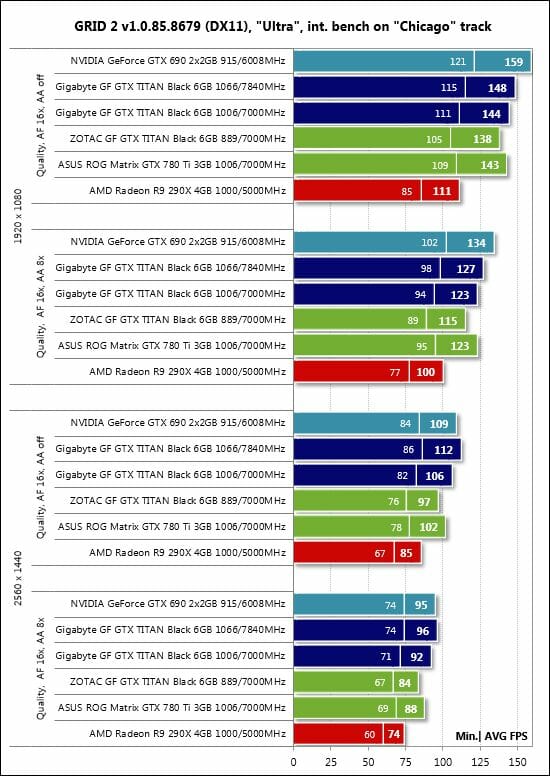
The GeForce GTX 690 is ahead at 1920×1080 but falls behind the overclocked Gigabyte GeForce GTX Titan Black GHz Edition at 2560×1440. The ASUS ROG Matrix GTX 780 Ti Platinum looks good in this game, beating the GeForce GTX Titan Black at the default clock rates.
Company of Heroes 2
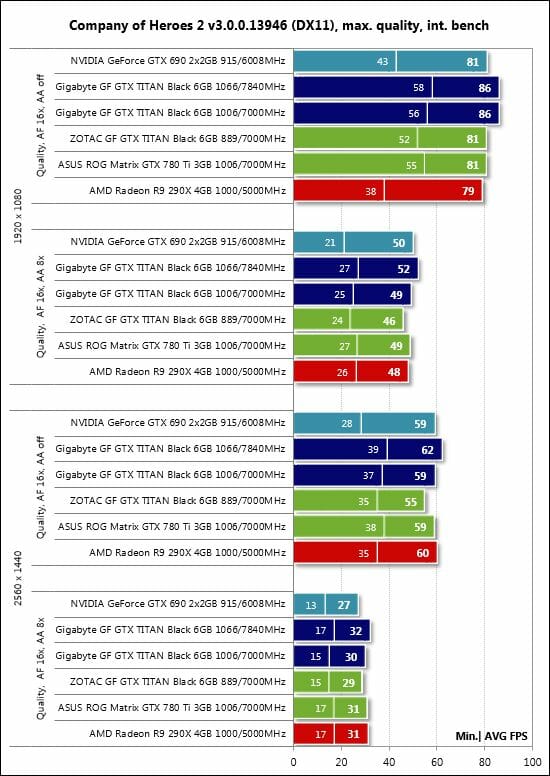
The Gigabyte GeForce GTX Titan Black GHz Edition is 6 to 7% ahead of the regular Titan Black and up to 11% faster than the dual-processor GeForce GTX 690. The solid performance of the AMD Radeon R9 290X must be noted as well.
Total War: Rome II
This game is known to require a lot of graphics memory at high resolutions when antialiasing is turned on, therefore the 6GB cards from Gigabyte and Zotac are ahead of the ASUS ROG Matrix GTX 780 Ti Platinum which only has 3 GB of onboard memory.
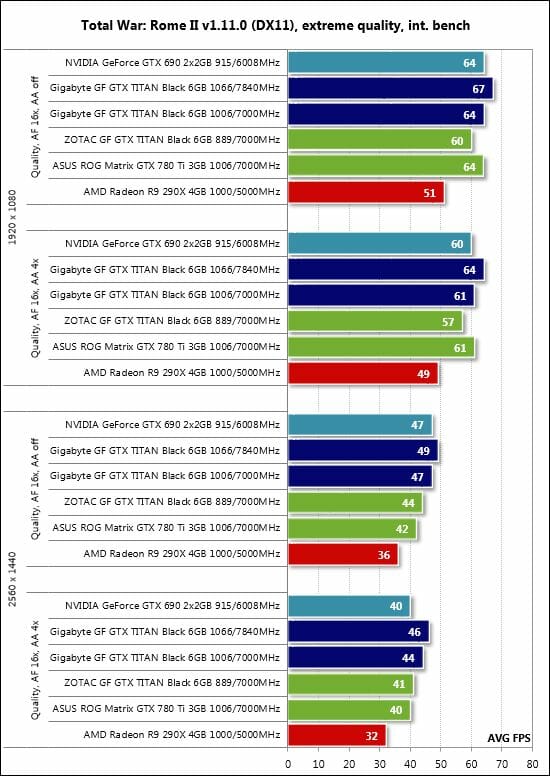
Batman: Arkham Origins
This game produces typical results for this test session.
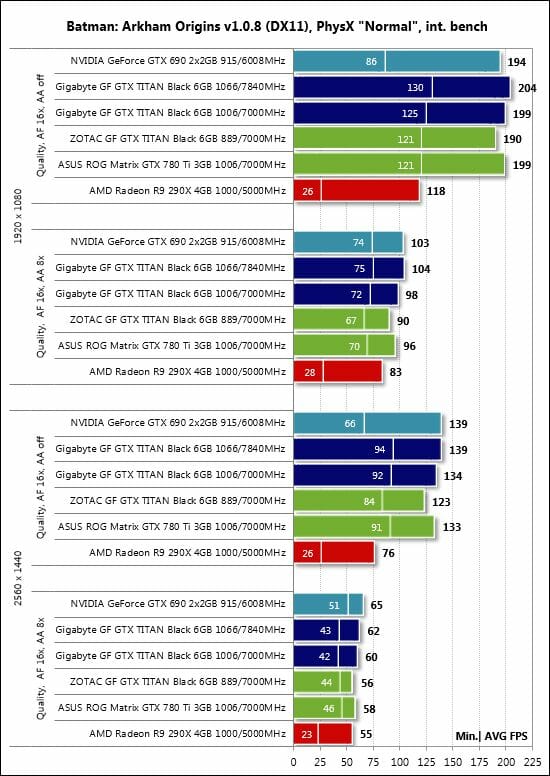
Battlefield 4
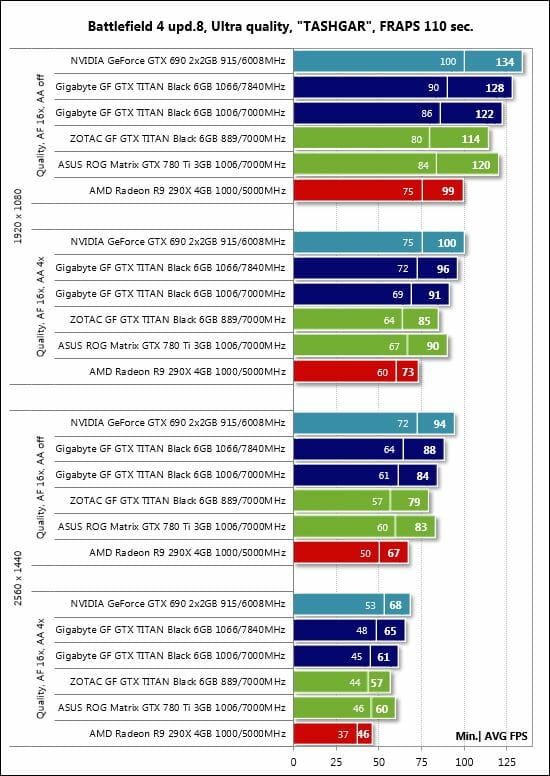
The standings are the same in this game but the gaps between the individual graphics cards are somewhat larger.
Thief
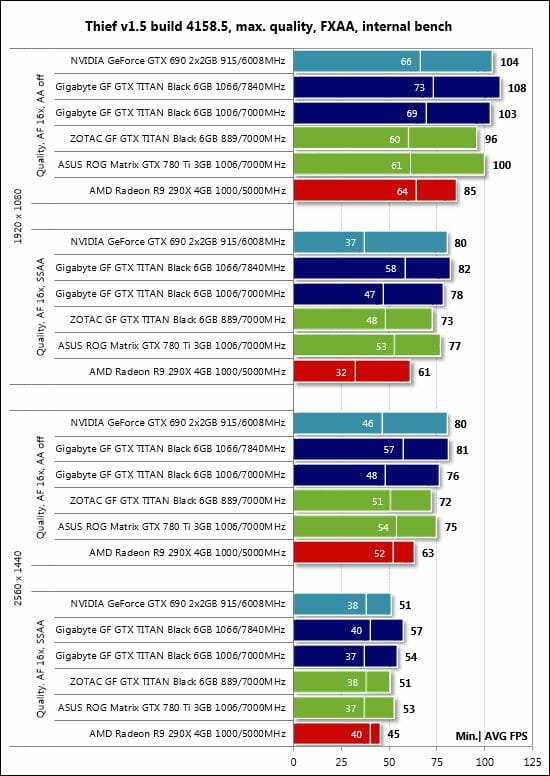
Here’s a table with the full test results showing the overall average and bottom speed for each graphics card.
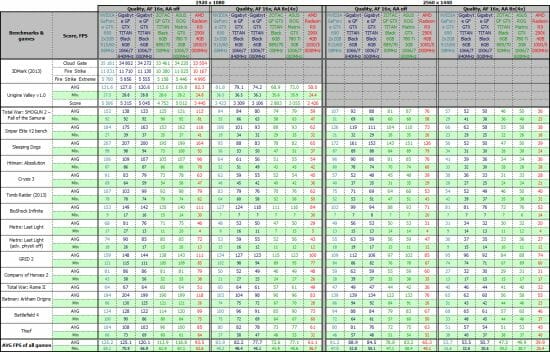
Now we can move on to our summary charts.
Performance Summary
First of all, let’s examine the difference between the Gigabyte GeForce GTX Titan Black GHz Edition 6GB (at 1006-1111/7000 MHz) and the Zotac GeForce GTX Titan Black 6GB (at 889-980/7000 MHz).
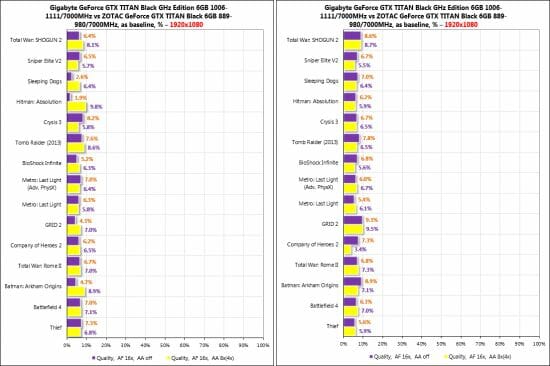
The Gigabyte is an average 6-7% faster than the Zotac across all of our tests, the biggest gap of 10% being observed in GRID 2 at the resolution of 2560×1440 pixels.
It’s also interesting to compare the Gigabyte GeForce GTX Titan Black GHz Edition and the ASUS ROG Matrix GTX 780 Ti Platinum. The difference between them boils down to the amount of onboard memory and the higher boost clock rate of the Gigabyte model. That’s why they deliver the same performance in practice.
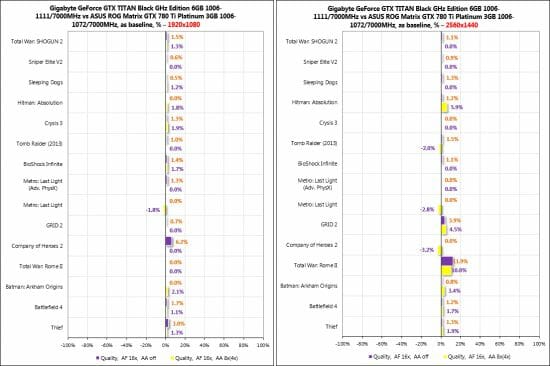
It is only in the high-quality test mode of Total War: Rome II at 2560×1440 that the Gigabyte’s advantage is as high as 10-12%. Otherwise, the two cards are equals.
And finally, we will compare the Gigabyte GeForce GTX Titan Black GHz Edition with the dual-processor Nvidia GeForce GTX 690.
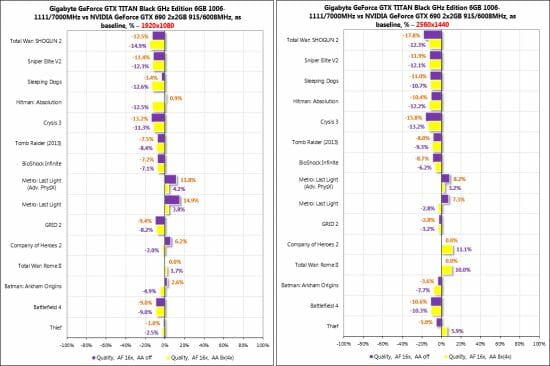
Despite the increased clock rates and three times more graphics memory per GPU, the Gigabyte GeForce GTX Titan Black GHz Edition cannot win this fight. It is only ahead in Metro: Last Light, in the high-quality test modes of Company of Heroes 2 and Total War: Tome II and also in Batman: Arkham Origins (with antialiasing turned on). In the rest of the games the Nvidia GeForce GTX 690 is at least as fast as its opponent and definitely faster in the relatively older games. So, people who bought their GTX 690 a couple of years ago can still rest assured that they own one of the best graphics cards available.
Performance in CUDA and OpenCL Applications
Besides traditional tests in 3D benchmarks and games, we will run a few computing and encoding programs that use CUDA (Compute Unified Device Architecture) and OpenCL algorithms. Only Nvidia-based products will be tested here. The Zotac GeForce GTX Titan Black is replaced with a reference GeForce GTX Titan in this section of our review.
First goes the SmoothVideo Project (SVP) benchmark SVPMark 3.0.3a. Here’s how many points the graphics cards scored in the GPU test.
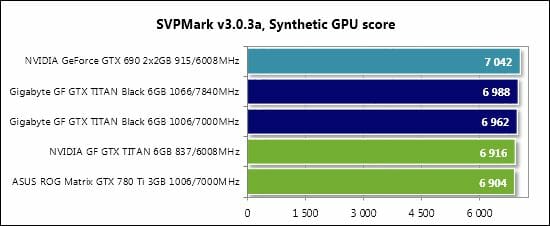
The graphics cards are close to each other, yet the dual-processor GeForce GTX 690 is the formal winner.
Next goes DirectCompute Benchmark version 0.45b. We show you both DirectCompute and OpenCL results.
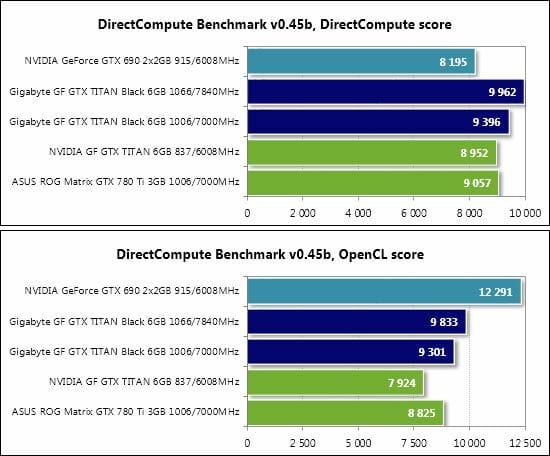
The Gigabyte GeForce GTX Titan Black GHz Edition wins the DirectCompute test but the dual-processor GeForce GTX 690 is superior in the OpenCL mode.
The last synthetic OpenCL test on our list is the GPGPU benchmark from the AIDA64 utility version 4.50.3006 beta. We show you the Single-Precision FLOPS and Double-Precision FLOPS results.
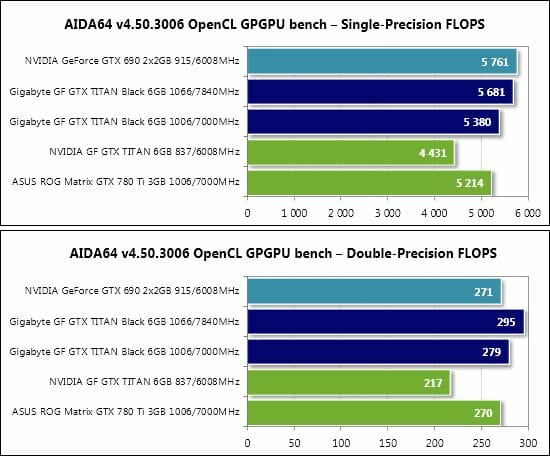
The Gigabyte GeForce GTX Titan Black GHz Edition is considerably faster than the reference Titan but the results of the ASUS ROG Matrix GTX 780 Ti suggest that the advantage is due to higher clock rates rather than to superior computing capabilities.
LuxMark is a more practical benchmark because it shows what performance we can expect from the graphics cards with the LuxRender engine.
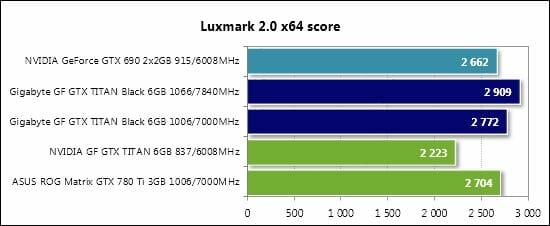
The Gigabyte GeForce GTX Titan Black GHz Edition wins this test, being 24.7% ahead of the reference GTX Titan. On the other hand, the ASUS ROG Matrix GTX 780 Ti is almost as fast as the Gigabyte.
Arion Bench version 2.5.0 is based on the Arion 2 technology and supports hardware acceleration on Nvidia GPUs. We use two rendering methods: hardware (on the GPU) and hybrid (GPU + CPU).
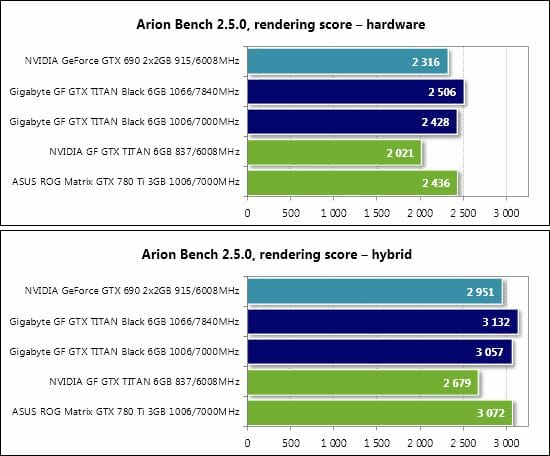
We’ve got the same standings here as in LuxMark above.
And finally, we benchmarked the speed of HD video encoding with Xilisoft Video Converter Ultimate version 7.8.1. We encoded a Full-HD 1.77GB video file (Disney’s Puss in Boots: The Three Diablos) for the iPad 4. The resulting file was about 441 MB large. The less time it took the card to transcode the video, the better.
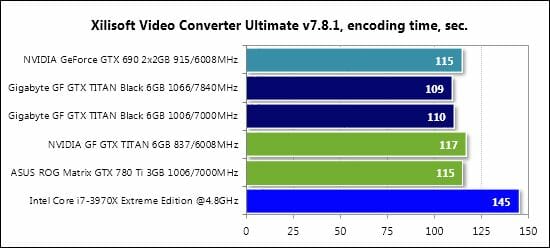
The 6-core Intel Core i7-3970X Extreme Edition processor clocked at 4.8 GHz shows the usefulness of CUDA because it is 25% slower than the fastest graphics card. And the utility can use up all of the CPU’s resources (its load level was 77% during the test). The graphics cards are comparable to each other, the Gigabyte being just a formal winner.
Power Consumption
We measured the power consumption of computer systems with different graphics cards using a multifunctional panel Zalman ZM-MFC3 which can report how much power a computer (the monitor not included) draws from a wall socket. There were two test modes: 2D (editing documents in Microsoft Word and web surfing) and 3D (the intro scene of the Swamp level from Crysis 3 running four times in a loop at 2560×1440 with maximum visual quality settings but without MSAA). Here are the results:
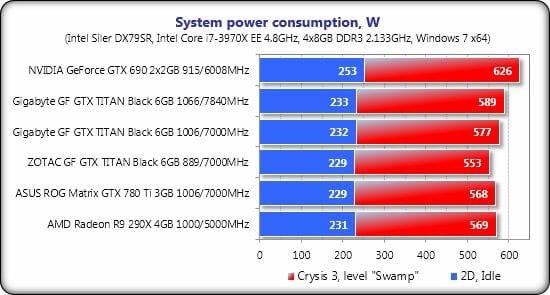
The tested configurations are comparable in terms of power draw with the exception of the dual-processor Nvidia GeForce GTX 690 which needs 37 watts more than the overclocked Gigabyte GeForce GTX Titan Black GHz Edition. The latter consumes 24 watts more than the reference Titan Black from Zotac which, oddly enough, is the most economical of all, and a mere 9 watts more than the ASUS ROG Matrix GTX 780 Ti Platinum. A 600-watt PSU is going to be sufficient for any configuration with a single-processor graphics card, just as recommended by their manufacturers.
Conclusion
The Gigabyte GeForce GTX Titan Black GHz Edition is the world’s fastest single-processor graphics card. When overclocked, it is even very close in performance to Nvidia’s dual-processor GeForce GTX 690. Notwithstanding the reference PCB design, Gigabyte increased the GPU clock rate by as much as 13.2%, which ensures a performance boost of 6-7%. But the key feature of the card is that it comes with two coolers, one of which is the excellent Windforce 3X 600W whose high performance (even with the overclocked Titan Black) and low noise level are going to be appreciated by ordinary users as well as overclockers.
The accessories to the card include a mouse pad and an HDMI cable. Its packaging is reliable and informative. And its 3-year warranty is going to please the buyer, too. We don’t think there will be too many buyers, though. The Gigabyte GeForce GTX Titan Black GHz Edition is very expensive, which is its only downside, actually. If you find its price too steep, you may want to prefer an overclocked GeForce GTX 780 Ti because it would deliver similar performance.